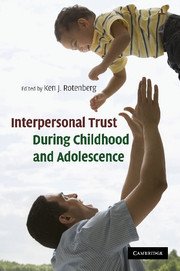Book contents
- Frontmatter
- Contents
- List of figures
- List of tables
- List of contributors
- Section I Conceptual foundations and issues
- 1 Introduction
- 2 The conceptualization of interpersonal trust: A basis, domain, and target framework
- 3 Neurobiology of interpersonal trust
- 4 Children's sense of trust in significant others: Genetic versus environmental contributions and buffer to life stressors
- Section II Childhood
- Section III Adolescence and early adulthood
- Index
- References
1 - Introduction
Published online by Cambridge University Press: 04 August 2010
- Frontmatter
- Contents
- List of figures
- List of tables
- List of contributors
- Section I Conceptual foundations and issues
- 1 Introduction
- 2 The conceptualization of interpersonal trust: A basis, domain, and target framework
- 3 Neurobiology of interpersonal trust
- 4 Children's sense of trust in significant others: Genetic versus environmental contributions and buffer to life stressors
- Section II Childhood
- Section III Adolescence and early adulthood
- Index
- References
Summary
Scholars throughout the world have advanced the principle that society cannot survive unless individuals establish and sustain basic levels of interpersonal trust (O'Hara, 2004; Uslander, 2002; Volker, 2002; Warren, 1999). Furthermore, interpersonal trust has been regarded as a crucial facet of human functioning since the very beginning of psychology as a discipline (Erikson, 1963; Hartshorne, May, and Maller, 1929). There is a growing body of evidence demonstrating that interpersonal trust across the course of development is linked to: physical health (e.g., Barefoot, Maynard, Beckham, Brammett, Hooker, and Siegler, 1998), cognitive functioning (e.g., Harris, 2007; Imber, 1973), social functioning (e.g., Rotenberg, Boulton, and Fox, 2005; Rotter, 1980), and the development and maintenance of close relationships (e.g., Holmes and Remple, 1989). Certainly, interpersonal trust plays a crucial role for physical health and psychosocial functioning during childhood and adolescence. Furthermore, because of developmental trajectories, interpersonal trust during childhood and adolescence should affect individuals by adulthood both directly (i.e., early trust affects later trust) and indirectly (i.e., via earlier links to health and psychosocial functioning). Unfortunately, there is a dearth of research on this topic. Indeed, most contemporary psychology books on childhood, adolescence, or developmental psychology fail to include any reference to interpersonal trust at all.
The purpose of this book is to redress that oversight and establish interpersonal trust during childhood and adolescence as a priority within the discipline of psychology. The book includes a selective set of chapters that address interpersonal trust during onset of adulthood as well as late adolescence.
- Type
- Chapter
- Information
- Publisher: Cambridge University PressPrint publication year: 2010
References
- 4
- Cited by

